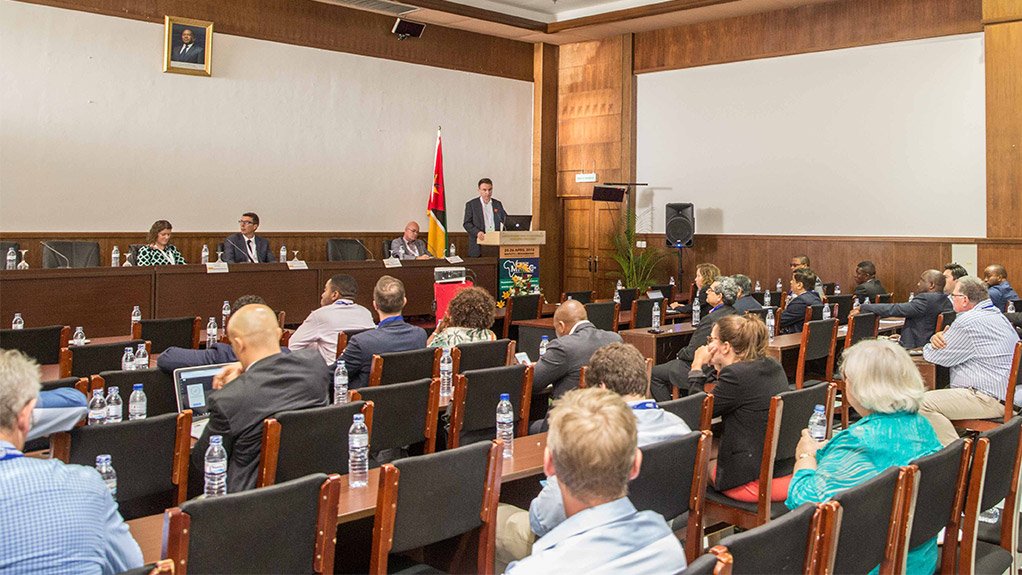The increase in international participation at the sixth edition of the Mozambique Mining, Energy and Natural Gas Conference (MMEC) reflected the state of the Mozambique mining industry, which is an emerging market, says event organiser AME Trade.
The conference was held in Maputo on April 25 and 26, with 74 speakers, 31 exhibitors and more than 830 visitors from 25 countries, including Japan, Spain, Angola and Turkey.
AME Trade marketing head Sergio Silva tells Mining Weekly that the increased international participation at the conference highlights that Mozambique is being revitalised by commodity prices rebounding paired with increased interest in investing in emerging markets, and that Mozambique’s mineral wealth makes the country “an appealing option to international investors”.
“Mozambique’s coal, rubies and natural gas have made international headlines, while specialised engineering consultants also see an opportunity to become involved in the more technical projects, particularly in liquefied natural gas,” explains Silva.
Conference Theme
MMEC 2018 focused on the theme: Developing Mozambique’s natural resources for industrialisation and value creation for the country. The event was organised in partnership with State-owned oil and gas company Empresa Nacional de Hidrocarbonates (ENH) and the Mozambican Mining Geology Association.
The conference discussed the different stages of the mining and hydrocarbon industries in the country, from the legal components to the business environment and the opportunities that may emerge in this regard.
The first day of the conference comprised several sessions, including Mozambique’s mining sector and its current projects, the latest mineral data and export potential. The conference also provided an overview of the country’s energy potential and strategic projects, and explored the ways in which legal and fiscal frameworks can create an attractive climate for mining exploration. Discussions also included oil and gas markets, the impact on current projects and gas monetisation strategies for the future, rural electrification focusing on accelerating access to power for all communities and local-content development in the extractive industries.
The second day of the conference focused on enabling Mozambique’s growth through economic policy and investment, investment development and financing sustainable projects to assist with economic growth. Notable discussions included a focus on monetary policy implications for international companies, and highlighted the Bank of Mozambique’s macroeconomic outlook for several industries, as well as how the country can take full advantage of its endowment from the mining, oil and gas and energy sectors.
Silva highlights that, following the conference and considering that the exports of coal have risen significantly, and natural gas projects are progressing well; “the State’s ability to generate revenue will increase, which will provide the opportunity to stabilise public finances, which, in turn, will give international lenders more confidence in Mozambique”.
Demand
Mozambique has the potential and the reserves to be a global leader in graphite production and currently has two graphite mines in production – the Balama and Ancuabe operations – with at least another two mines likely to be commissioned soon, according to the AME Trade Post Show Report.
Silva says China has played a significant role in developing some of the projects in the country to a more advanced stage. An example of this is that graphite miner Triton Minerals signed an offtake agreement with a major Chinese graphite company last month for its graphite production project in Mozambique, he notes.
Graphite is in significant demand because it is a cheaper alternative to the manufacture of flame retardants, which also uses graphite; it also has a higher thermal efficiency and dense composition.
Additionally, the sector of pigment production using the chloride method in China is growing and requires high-quality ilmenite for this process, which makes Mozambique’s heavy mineral sands mining quite promising. Current mineral sands operations in the country include mineral sands miner Kenmare Resources’ Moma mineral sands mine, in Nampula.
Socioeconomic Focus
Other factors contributing to the positive state of the mining industry are the record coal-export levels; gas megaprojects, such as those of gas exploration company Anadarko; and renewable-energy projects that are under way.
“These factors are crucial for the socioeconomic development of Mozambique, and having all these industries under one roof was a key highlight of MMEC 2018.”
Silva emphasises that mining companies should focus more on community engagement, adding that establishing a strong social licence to operate will be important. “Nationalism and popular politics are on the rise and the mining industry, with its current public profile, is a prime target for nationalisation policies.
”
Edited by: Mia Breytenbach
Creamer Media Deputy Editor: Features
EMAIL THIS ARTICLE SAVE THIS ARTICLE
ARTICLE ENQUIRY
To subscribe email subscriptions@creamermedia.co.za or click here
To advertise email advertising@creamermedia.co.za or click here













